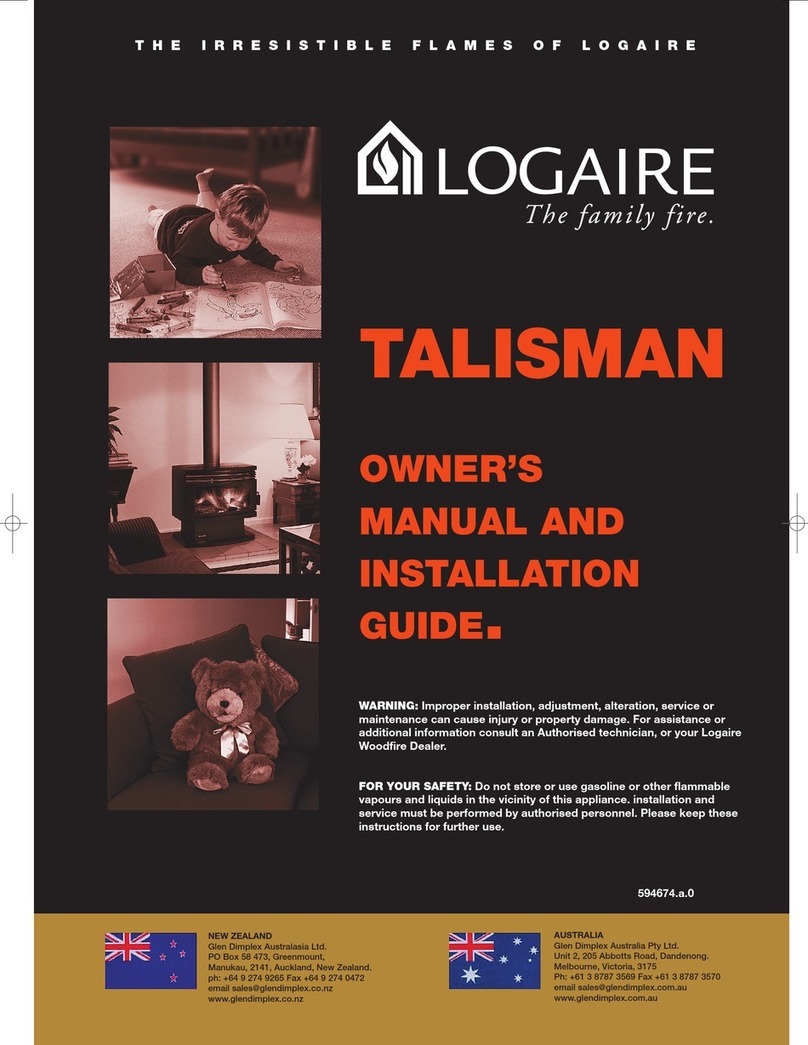Move the heat output control away from the maximum position only after the fire is well established. A
new woodfire should not be run at higher than half setting beyond the first 30 minutes until it has been
used for a total of 8 hours. Once fully ‘run in’, we recommend running at full heat for up to one hour
after lighting as this will minimise creosote build-up in the flue. The control can then be set wherever
desired.
The special high temperature paint on the firebox will emit some smoke as it cures during the first hour
or so of running. This is quite normal.
CAUTION: THIS APPLIANCE SHOULD NOT BE OPERATED WITH A CRACKED GLASS
OPERATING HINTS FOR CLEAN BURNING AND BEST EFFICIENCY
FUEL: USE ONLY WOOD THAT HAS BEEN AIR DRIED IN A SHELTERED WELL
VENTILATED STACK, PREFERABLY FOR AT LEAST 12 MONTHS. If moist fuel must be used,
add it only to a really hot fire, mixing it with a large proportion of dry fuel. In Clean Air Zones, only
wood may be used as fuel, and it must have a moisture content not greater than 25% (measured on a
dry weight basis, in line with ECan’s rule AQL 5).
•Do not burn driftwood as salt will corrode the woodfire and flue.
CAUTION: THE USE OF SOME TYPES OF PRESERVATIVE TREATED WOOD AS FUEL CAN
BE HAZARDOUS.
•Add fuel reasonably often. A large fuel load placed on a dying fire can drop combustion
temperatures undesirably.
•Avoid large smouldering fires. A small intense fire is more efficient.
•Move the heat control to maximum for a minute or so and turn off the air circulating fan (if fitted)
before opening the door on a low burning fire. This will clear away any fumes in the firebox.
•Always open the door SLOWLY, and close and latch it shut securely again as soon as possible after
re-loading.
•When loading fuel, place the pieces of wood in a front-to-back direction to ensure good air access
and the cleanest possible burning.
•Load fuel carefully to avoid damage to the insulating boards, firebricks or top baffle.
•If smoke wafts into the room from a fully established fire while the door is open, first check that
make-up air can flow freely into the room to replace the air passing up the flue. (See box below).
Then check that the flue is not obstructed in any way, particularly by the rain cap being too close to the
end of the flue. (See the flue cleaning requirements in the Maintenance section, page 9). If these checks
do not uncover the fault, add an extra length of flue (bracing it, if necessary) to counteract the down
draught effects caused by roof shape, nearby buildings, hills or trees.
•Switch off the circulating fan (if fitted) when the fire is burning at low heat outputs. Use only the
slow fan speed at medium heat output, moving to the higher speed(s) only when full heat output has
been reached.
•Adjust the door to eliminate any minor leakage. (See MAINTENANCE - page 9). Serious leakage
will require a new door seal.
REMEMBER, FOR THE FIRE TO DRAW PROPERLY, AIR MUST BE ABLE TO
ENTER THE ROOM WHERE YOUR WOODFIRE IS INSTALLED. YOU MAY
HAVE TO LEAVE A DOOR SLIGHTLY OPEN AND PERHAPS A WINDOW
ELSEWHERE IN THE HOUSE IF YOUR HOME IS OF MODERN AIRTIGHT
CONSTRUCTION. THIS IS PARTICULARLY IMPORTANT IF AN AIR
EXTRACTION FAN IS OPERATING SOMEWHERE IN THE HOUSE. LEAVING
THE ROOM DOOR OPEN WILL HELP SPREAD WARMTH THROUGH THE
REST OF YOUR HOME.
8




























